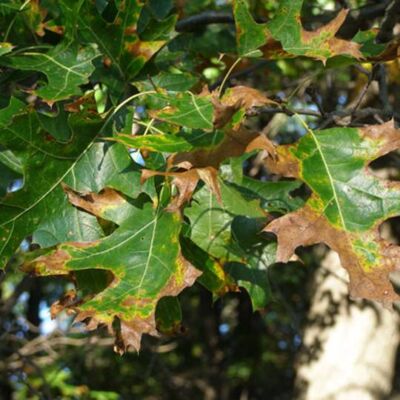All About Oak Wilt
Oak Wilt is a vascular disease caused by the fungal pathogen Bretziella fagacearum. The first known case of Oak Wilt in Canada was confirmed in Niagara Falls in May 2023. Although all oak species are vulnerable, the red oak group (red, black, and pin) are most susceptible, frequently resulting in death within 2-12 months of infection. Species in the white oak group (burr, swamp white, and white) are more tolerant of the disease and may survive infection for one or more years while displaying declining symptoms.
The fungus grows on the outer sapwood beneath the bark of infected oaks, restricting the flow of water and nutrients within the tree. The fungus is spread from infected to healthy trees by two means: insects carrying the fungal spores and through root graphs. In addition, the fungus can be spread by people moving infected wood products, firewood, and nursery stock.
When a diseased red oak dies, fungal mats develop on the trunk in the spring and fall (these mats are not produced on living trees or white oaks). The fungal mats, which emit a sweet aroma, attract Nitidulid beetles, also known as sap or picnic beetles. While feeding, the sticky spores adhere to the insect’s body, which they then carry from infected trees to fresh wounds on heathy trees.
To help reduce the spread of Oak Wilt, avoid pruning oak trees between April and August.
While insects are an important dispersal mechanism, it is estimated that 90 percent of new infections occur between neighbouring trees through root grafts. While the fungus can survive above-ground for a year after the tree has died, it can survive considerably longer on tree roots below-ground, and intertwining roots facilitate infection to adjacent oak trees.
Signs and Symptoms of Oak Wilt:
- The leaves wilt and turn bronze or yellow, starting at the top of the tree. Discoloration begins at the leaf tip and moves towards its center.
- Early and sudden leaf drop.
- White, grey or black fungal mats form under the bark of dead trees and often have a fruity smell.
- Pressure pads split or crack the trunk as the fungal mat pushes outward.
- A black stain forms in the sapwood of the tree.

Further can be found on the Invasive Species Centre website by clicking here.
For questions, please contact: Brenda Gallagher, Forestry Technician.

